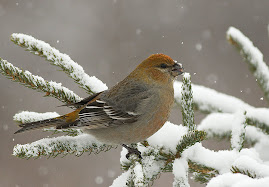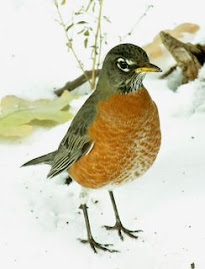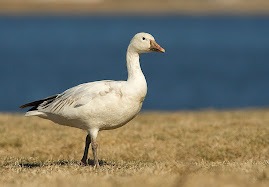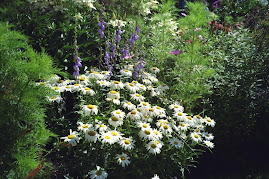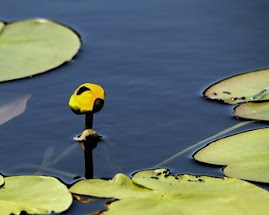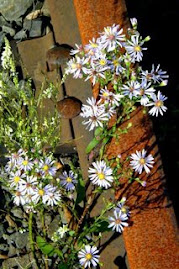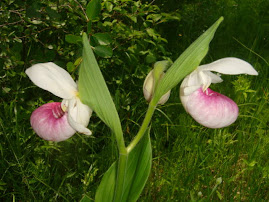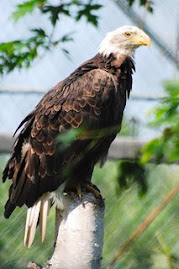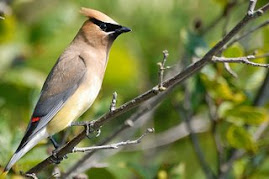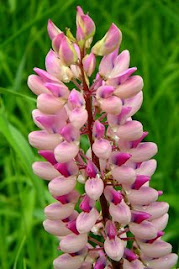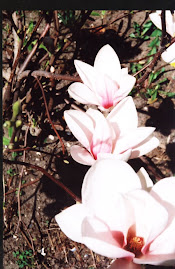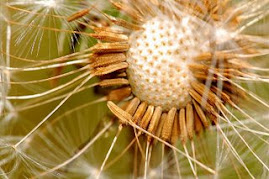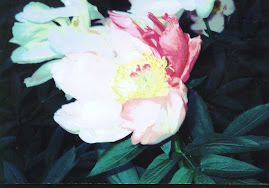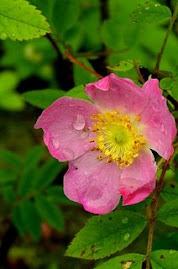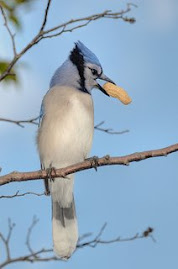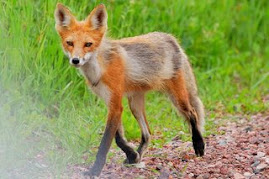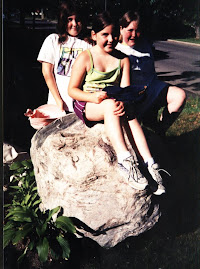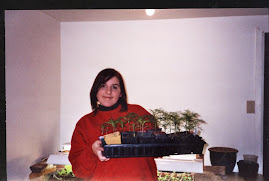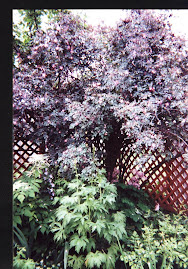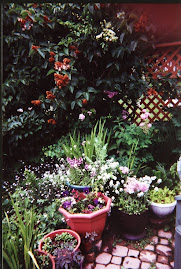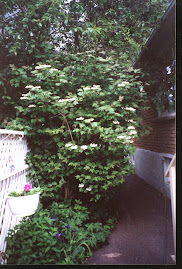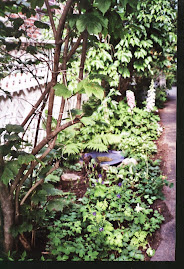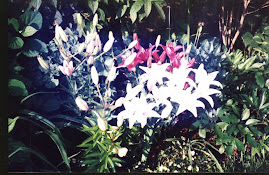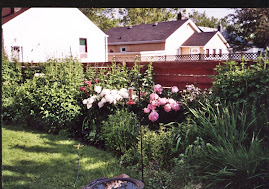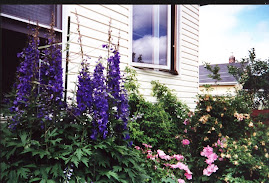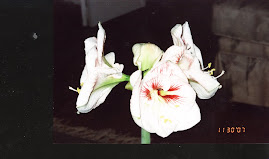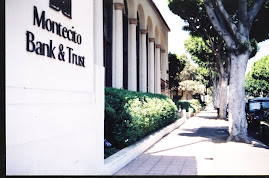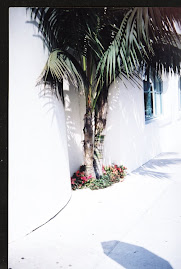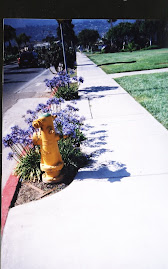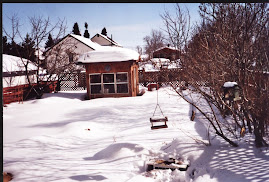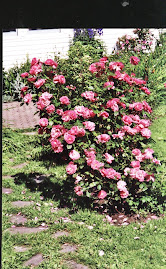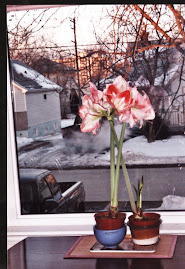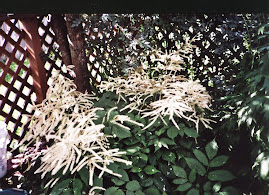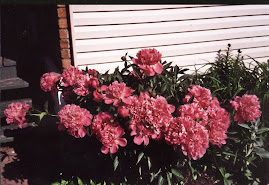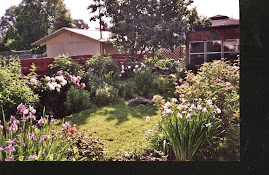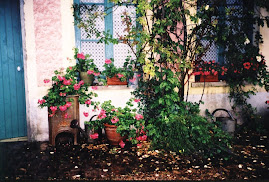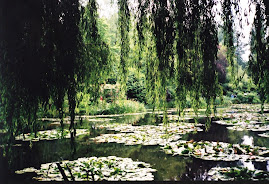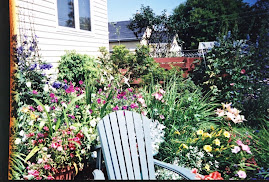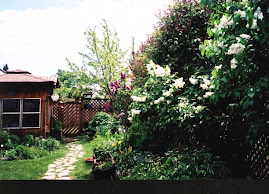Plants in various stages (or no discernible stage at all) are all over the house. I have three florescent shop lights set up on tables in the basement holding flats, pots and cell packs with tiny plants – impatiens (two flats), geranium (three cell packs), basil ( a flat of cell packs), lobelia (one flat) and nicotania (one six inch pot – still too tiny to put in cells), godetica(one flat of teeny plants).
Also down the basement is a planted flat of cilantro seeds and two of cosmos all under plastic domes. Two six inch pots hold schizanthus seeds, the divas of the seed world and hell to germinate. The pots are inside ziplocks. The ziplocks are inside a green plastic garbage bag. This plant germinates in the dark, if it deighns to do so.
In the warm back porch sits a lone zip lock containing a six inch pot containing a few wave petunia seed. On a low shelf, a six inch pot hides under a draped tea towel, an attempt to germinate parsley seeds. The temperature there is 24 C.
Inside the house, at 20 degrees C, are two zip locks containing hibiscus and rosemary seeds – so far no action there. In the kitchen is a flat with a plastic dome containing dianthus seeds.
I keep running around the house with my thermometer to check if the temperature is within the required range.
Sunday 30 March 2008
Thursday 27 March 2008
THE WILD FLOWER GARDEN, part 1.
I have been given a gift, a pack of wild flower seeds. A thoughtful present but I am not sure what to do with it. The seeds are packaged by OSC seeds, a southern Ontario nursery in Waterloo. Most likely the wild flowers are southern Ontario varieties and therefore, dicey for the north. If would have been helpful if OSC had listed the names of the flower species on the packet but they did not. Most seed mixtures like this one do not list the contents, therefore, it's a pig in a poke. The blurb says the packet contains a mixture of annuals and perennials and will reseed themselves every year. Well, maybe.
As a general rule, I do not like seed mixtures but I see they are sold all over town. I would like to hear from someone who has had success with them.
It seems strange that a Northerner, surrounded by thousands of square miles of wild plants, would attempt to grow southern Ontario wild flowers. Growing our own northern species is a good way to attract birds. The local nurseries offered a good selection of native plants last year. Last July, I bought two common mullein plants from George’s Market for my dry front garden. I’m hoping they’ll take to the conditions there. These biennial plants form a rosette of pale green hairy leaves the first year and the second year produce a six foot stalk with yellow flowers. Let us hope!
I know a very nice garden created from plants liberated from the back lanes of Fort William. The gardener also found a few plants at a gravel pit and along an abandoned railway. These dry-land plants are more successfuly transpalnted han the woodland varieties.
In Thunder Bay, lovely volunteers arrive in every garden, carried by those busy gardeners – the wind and the birds. From them, I received feverfew, ox-eye daisies, yarrow, black eyed Susans, sunflowers, tansy, Queen Anne’s lace, golden rod and campanula, (or bell flower, both purple and white). Many of these, such as the ox-eye daisy, are introduced species or garden cultivars gone wild. Such is common tansy, a fine garden plant. Others, such as the goldenrod and black-eyed susans, are native.
Some people bring in plants from camp or their bush property but it is a tricky business. The soil in the deep bush is acidic and the woodland plants need the right conditions to grow. Many native wild flowers usually bloom only once a year and only for a short time. However, some are quite showy. I see a lot of Joe Pye Weed around town. If you have a dampish spot, this big brawny plant may be a good choice.
So IMHO, if you want a wild flower garden, get plants from this area. Go slowly and see what will take to your city plot. Shrubs such as wild rose, high bush cranberry and mountain ash often do well. On your garden walks, check what is growing around town. Look at the back lanes and empty lots for ideas.
As a general rule, I do not like seed mixtures but I see they are sold all over town. I would like to hear from someone who has had success with them.
It seems strange that a Northerner, surrounded by thousands of square miles of wild plants, would attempt to grow southern Ontario wild flowers. Growing our own northern species is a good way to attract birds. The local nurseries offered a good selection of native plants last year. Last July, I bought two common mullein plants from George’s Market for my dry front garden. I’m hoping they’ll take to the conditions there. These biennial plants form a rosette of pale green hairy leaves the first year and the second year produce a six foot stalk with yellow flowers. Let us hope!
I know a very nice garden created from plants liberated from the back lanes of Fort William. The gardener also found a few plants at a gravel pit and along an abandoned railway. These dry-land plants are more successfuly transpalnted han the woodland varieties.
In Thunder Bay, lovely volunteers arrive in every garden, carried by those busy gardeners – the wind and the birds. From them, I received feverfew, ox-eye daisies, yarrow, black eyed Susans, sunflowers, tansy, Queen Anne’s lace, golden rod and campanula, (or bell flower, both purple and white). Many of these, such as the ox-eye daisy, are introduced species or garden cultivars gone wild. Such is common tansy, a fine garden plant. Others, such as the goldenrod and black-eyed susans, are native.
Some people bring in plants from camp or their bush property but it is a tricky business. The soil in the deep bush is acidic and the woodland plants need the right conditions to grow. Many native wild flowers usually bloom only once a year and only for a short time. However, some are quite showy. I see a lot of Joe Pye Weed around town. If you have a dampish spot, this big brawny plant may be a good choice.
So IMHO, if you want a wild flower garden, get plants from this area. Go slowly and see what will take to your city plot. Shrubs such as wild rose, high bush cranberry and mountain ash often do well. On your garden walks, check what is growing around town. Look at the back lanes and empty lots for ideas.
Labels:
black eyed susans,
mullein,
native plants,
wild flower gardens
Tuesday 25 March 2008
PLANT ON
Today I planted one packet each of nicotania, wave petunias, parsely, rosemary, and hibiscus. All were alike in one respect, each pack had very few seeds, far too few to plant in flats. (I note here that you should never plant different types of seeds in a single flat. Each plant has its own special conditions for germination and growing. Some are quick growers, others laggards. Planting different things in a single flat is a recipe for frustration.)
I fill six inch pots with moist pro mix, plant the seeds as per instructions on the packet and place the entire pot inside a big zip lock and close the top. This bag acts as a moisture and heat retaining dome. The pot does not have to be watered as long as it is in the bag.
Note: no fertilizer is used at any stage so far. I do use a few drops of Damp-Off in a gallon of warm water to mix with the Pro mix.
A note about nicotania. This is a great annual flower and easy to grow, There are dwarf, tall and very tall varieties. Only the tall variety has any scent. There are also great colours – for example Stokes has a lime variety which looks great with the white. It germinates at room temperature and so the plastic bag sits on top of my computer. This year I am trying very tall.
I only planted one pack of Wave petunias. I find them tricky to get started and the seeds are expensive. (50 cents a seed!). I think the white waves look wonderful at the edge of pots. The white is almost luminous. These need heat to germinate and are in my warm back porch.
Hibiscus. This is the fist time I have grown this annual type. I was seduced by the description in the seed catalogue, not the first time this has happened.
I fill six inch pots with moist pro mix, plant the seeds as per instructions on the packet and place the entire pot inside a big zip lock and close the top. This bag acts as a moisture and heat retaining dome. The pot does not have to be watered as long as it is in the bag.
Note: no fertilizer is used at any stage so far. I do use a few drops of Damp-Off in a gallon of warm water to mix with the Pro mix.
A note about nicotania. This is a great annual flower and easy to grow, There are dwarf, tall and very tall varieties. Only the tall variety has any scent. There are also great colours – for example Stokes has a lime variety which looks great with the white. It germinates at room temperature and so the plastic bag sits on top of my computer. This year I am trying very tall.
I only planted one pack of Wave petunias. I find them tricky to get started and the seeds are expensive. (50 cents a seed!). I think the white waves look wonderful at the edge of pots. The white is almost luminous. These need heat to germinate and are in my warm back porch.
Hibiscus. This is the fist time I have grown this annual type. I was seduced by the description in the seed catalogue, not the first time this has happened.
Sunday 23 March 2008
LIGHTS! ACTION!
I do not use light stands. They are expensive and not very flexible. The only valid use for a light stand, IMHO, is decorative, growing plants in an apartment living room, for example.
Florescent lights have to sit very close to the plants, only an inch or two above them. I use regular Canada Tire shop light fixtures (4 feet long) set up on a table using bricks. I buy the light fixtures with the square ends, attach a regular plug to the wires and put in two cool florescent tubes. I set each square end on a couple of bricks laid sideways. I plug the light into a light bar so that I can turn them on and off with a switch. I like to buy light bars with long cords so that they reach my sparse electrical outlets. I can set up four lights on one long table and plug all into a single light bar. Later, when things start hopping, I attach a timer to the light bar.
By the end of April, I have about thirteen lights set up, most in the cool basement and a few in the warm porch.
Note: Florescent lights are cool to the touch and do not burn the plants even if they touch the lights.
Florescent lights have to sit very close to the plants, only an inch or two above them. I use regular Canada Tire shop light fixtures (4 feet long) set up on a table using bricks. I buy the light fixtures with the square ends, attach a regular plug to the wires and put in two cool florescent tubes. I set each square end on a couple of bricks laid sideways. I plug the light into a light bar so that I can turn them on and off with a switch. I like to buy light bars with long cords so that they reach my sparse electrical outlets. I can set up four lights on one long table and plug all into a single light bar. Later, when things start hopping, I attach a timer to the light bar.
By the end of April, I have about thirteen lights set up, most in the cool basement and a few in the warm porch.
Note: Florescent lights are cool to the touch and do not burn the plants even if they touch the lights.
THOUGHTS ABOUT GERANIUMS
The catalogue information on geranium Maverick white claims there are 10 seeds to a pack. I only count nine. I rip the pack apart but no lost seed. The pack cost $3.85 or over 38 cents a seed - a bargain really. In Thunder Bay small geraniums sell for a buck or more. Other plants are much cheaper. The lavatera pack holds 100 seeds at $1.95 a seed or just under two cents a plant. Wave petunias seeds are usually the most expensive annual seeds in the catalogue.
Sometimes it is difficult to tell how many seeds are in a pack. Some seed companies omit this important information. Sometimes it is in the catalogue and sometimes not.
Last night I took the wet paper towel packet with the NINE germinated geranium seeds and lifted them out holding on to the tiny leaves. They came away from the towel easily. I pressed them into the plastic four packs (saved from nursery purchases. Some of my four and six packs are so old they are held together with duct tape). Accordign to the directions on the packet, the four packs have to be left under lights continually for three days and then drop to 16 hours a day.
Sometimes it is difficult to tell how many seeds are in a pack. Some seed companies omit this important information. Sometimes it is in the catalogue and sometimes not.
Last night I took the wet paper towel packet with the NINE germinated geranium seeds and lifted them out holding on to the tiny leaves. They came away from the towel easily. I pressed them into the plastic four packs (saved from nursery purchases. Some of my four and six packs are so old they are held together with duct tape). Accordign to the directions on the packet, the four packs have to be left under lights continually for three days and then drop to 16 hours a day.
Saturday 22 March 2008
Jubilation! Germination!
The impatiens showed their "milk leaves" or first leaves last night. I will have plenty of plants for the shade garden. The seeds germinated in a flat with a plastic dome - all set under lights. (following the directions on the seed packet). Tomorrow, after the slow guys push their way to the top, I will remove the dome, move the flat to the cooler basement and set under the lights there for 16 hours a day. More about the lights set-up later.
I planted some old basil seeds in a six inch pot and set the entire thing inside a big zip lock bag and put it in my warm porch in the sun. Old seeds usually have a poor germination rate but not these - the pot is crowded with tiny basil sprouts after only a few days. This is Genovese basil which I believe has the best flavour.
The geraniums planted in coffee filters did not germinate. The ones on the wet paper towel have sprouts. Moral - always follow the advice on the seed packet. I quickly moved the still dry seeds from coffee filter to warm, wet paper towel, folded them up into a packet about 4 inches square and put them back into the zip lock bags. Back to the warm porch. I will transplant all sprouted geraniums tonight. More info on that later.
I planted some old basil seeds in a six inch pot and set the entire thing inside a big zip lock bag and put it in my warm porch in the sun. Old seeds usually have a poor germination rate but not these - the pot is crowded with tiny basil sprouts after only a few days. This is Genovese basil which I believe has the best flavour.
The geraniums planted in coffee filters did not germinate. The ones on the wet paper towel have sprouts. Moral - always follow the advice on the seed packet. I quickly moved the still dry seeds from coffee filter to warm, wet paper towel, folded them up into a packet about 4 inches square and put them back into the zip lock bags. Back to the warm porch. I will transplant all sprouted geraniums tonight. More info on that later.
Thursday 20 March 2008
Five Stupid Mistakes I’ve Made Planting Seeds Indoors
1. Throwing away the seed packet. I planted the seeds, tossed packets in the garbage. Yikes! Later I need further info on growing conditions etc but too late – gone.
2. Tearing off the name of the plant. Open the seed packet and plant seeds and save packet - yeah right. When I tore open the packet, I ripped off the plant name and now I have packets with no names on them and no idea which plants they belongs to. Moral - Always open from the bottom of the packet.
3. Growing plants in styro cups. One year I had a lot of cups left over from the summer. When my plants were small bushy things and were outgrowing the four- packs, I transplanted them into the styros. They grew well. Now to plant them outside. That was when I found that the roots had grown into the styro and could only be loosened by pulling, teasing out, cutting, tearing, swearing… Moral – plant in plastic nursery pots and flats. (or Tim Horton’s cups).
4. Not watching the grandchildren. Here comes the four year old! He has removed all the name tags from the flats and collected a nice little pile. Many mystery plants were grown that year.
5. And the worst mistake I ever made planting seeds was the following. I mix the planting medium (pro-mix) with warm water in a large plastic tub. One year I looked after my daughter’s cat. Cat had a kitty litter box in the laundry room but she also checked out the planting table, found the tub full of pro-mix and warm water and liked it a lot better. Moral – when you have a cat in the house, cover the planting mix
2. Tearing off the name of the plant. Open the seed packet and plant seeds and save packet - yeah right. When I tore open the packet, I ripped off the plant name and now I have packets with no names on them and no idea which plants they belongs to. Moral - Always open from the bottom of the packet.
3. Growing plants in styro cups. One year I had a lot of cups left over from the summer. When my plants were small bushy things and were outgrowing the four- packs, I transplanted them into the styros. They grew well. Now to plant them outside. That was when I found that the roots had grown into the styro and could only be loosened by pulling, teasing out, cutting, tearing, swearing… Moral – plant in plastic nursery pots and flats. (or Tim Horton’s cups).
4. Not watching the grandchildren. Here comes the four year old! He has removed all the name tags from the flats and collected a nice little pile. Many mystery plants were grown that year.
5. And the worst mistake I ever made planting seeds was the following. I mix the planting medium (pro-mix) with warm water in a large plastic tub. One year I looked after my daughter’s cat. Cat had a kitty litter box in the laundry room but she also checked out the planting table, found the tub full of pro-mix and warm water and liked it a lot better. Moral – when you have a cat in the house, cover the planting mix
Labels:
cats,
grandchildren,
Mistakes planting indoors,
styro cups
Planting Geraniums
Geraniums require warmth to germinate says the seed packet, This is the first time I have grown geraniums. The packet suggests starting the seed on moist paper towels but I find coffee filters better - they do not fray apart. I wet the filter with warm water, squeeze it out and sprinkle the seed on a third of the circle and fold it in half and then into a cone shape. I put the filter into a ziplock and on the shelf in my heated back porch. The impatiens and lobelia in their flats are out there too. Geraniums are quick to germinate, it sez here. I plant only three packs, two shades of pink and a white. There are only a few seeds in a pack.
Saturday 15 March 2008
Starting the Seeds at Last!
The season has started! On March 10, I planted two flats of impatiens (elfin blend) seeds. These are dwarf plants of mixed colours for the shade garden. March 15, I planted one flat of Crystal Blue Lobelia.
I use Pro Mix to start seeds. The Pro-mix I bought this year from Creekside (about 25$ a bale) has a wetting agent and MYCORISE, the new star of the garden. This is a beneficial fungus that works in symbiosis with the roots of the plant, taking sugar from the roots and increasing the plant's acquisition of nutrients and water - or that's the plan anyway. Some readers might have bought the stuff called MYKE which is basically the same thing. I used MYKE when I planted my tulips in the fall of 2006 and I had a good year in 2007 so I am sort of sold but not entirely. There is no scientific way to tell if my success was due to MYKE but I am going to try this new style pro-mix and, as usual, hope for the best.
Years ago I tried starting seeds in soil but found it compacted too much. Sterile potting soil is also expensive. I have even heard of people sterilizing garden soil in the oven - work, work and what a mess! The pro-mix planting medium is the answer. I usually use two bales a season. I recycle the pro-mix, more about this later.
I plant in plastic flats that have holes in them for drainage. The seed flat is placed inside another without holes. This underflat will catch the water. Over the top, goes a clear plastic cover. Most of my plastic containers have been used for years and a lot of them are held together with duct tape. When my supply of plastic flats and covers run out, I have some sneak ways of creating substitutes that I will mention in another post.
I mix the Pro-mix with warm water (I have a unscientific belief that seeds do better in warm water). I use a big plastic tub and mix with my gloved hands and then fill the flats about three quarters of an inch from the top. There has to be room for watering as the growing plants push up the soil. Using a waterproof felt marker, I note the name of the plant and date on a label and stick it in one corner of the flat. Don't make the labels too tall, an inch or an inch and a half is enough. Tall labels catch on edges as the flats are moved around and they may fall out. I cut up old venetian blinds for labels but I have also made labels out of any firm plastic such as strips cut from plastic cups. I do not like commercial labels; they are too tall and cost $.
Watch for the next post - mistakes I have made over the years trying to start seeds.
I use Pro Mix to start seeds. The Pro-mix I bought this year from Creekside (about 25$ a bale) has a wetting agent and MYCORISE, the new star of the garden. This is a beneficial fungus that works in symbiosis with the roots of the plant, taking sugar from the roots and increasing the plant's acquisition of nutrients and water - or that's the plan anyway. Some readers might have bought the stuff called MYKE which is basically the same thing. I used MYKE when I planted my tulips in the fall of 2006 and I had a good year in 2007 so I am sort of sold but not entirely. There is no scientific way to tell if my success was due to MYKE but I am going to try this new style pro-mix and, as usual, hope for the best.
Years ago I tried starting seeds in soil but found it compacted too much. Sterile potting soil is also expensive. I have even heard of people sterilizing garden soil in the oven - work, work and what a mess! The pro-mix planting medium is the answer. I usually use two bales a season. I recycle the pro-mix, more about this later.
I plant in plastic flats that have holes in them for drainage. The seed flat is placed inside another without holes. This underflat will catch the water. Over the top, goes a clear plastic cover. Most of my plastic containers have been used for years and a lot of them are held together with duct tape. When my supply of plastic flats and covers run out, I have some sneak ways of creating substitutes that I will mention in another post.
I mix the Pro-mix with warm water (I have a unscientific belief that seeds do better in warm water). I use a big plastic tub and mix with my gloved hands and then fill the flats about three quarters of an inch from the top. There has to be room for watering as the growing plants push up the soil. Using a waterproof felt marker, I note the name of the plant and date on a label and stick it in one corner of the flat. Don't make the labels too tall, an inch or an inch and a half is enough. Tall labels catch on edges as the flats are moved around and they may fall out. I cut up old venetian blinds for labels but I have also made labels out of any firm plastic such as strips cut from plastic cups. I do not like commercial labels; they are too tall and cost $.
Watch for the next post - mistakes I have made over the years trying to start seeds.
Friday 7 March 2008
IMAGINE: LIFE WITHOUT A LAWN
Tired of the rituals of fertilizing, weeding, watering, mowing and maintaining? In an article in this month’s issue of All Season’s Garden Guide, Doreen G. Howard suggests alternatives using meadow plants, succulents or moss.
She lists the benefits of eliminating or reducing turf – saving time – saving money – saving water – more flowers – fragrance – more birds – beneficial bugs – few or no chemicals and (maybe) fresh produce. There are several lawn-less front yards around Thunder Bay. Most use a mix of shrubs, perennials, garden rocks and various ground covers or cedar chips. A few go for the wild flower effect, not always easy to do.
Are there any advantages to lawns? Yes. Nothing is tougher than turf for children’s play areas or sports fields. Mown turf beside pathways eliminates wet and slippery plants from flopping on the path after a hard rain. And green lawn sets off garden beds in an artistic way.
But just think – never pull another dandelion again! It is a thought
She lists the benefits of eliminating or reducing turf – saving time – saving money – saving water – more flowers – fragrance – more birds – beneficial bugs – few or no chemicals and (maybe) fresh produce. There are several lawn-less front yards around Thunder Bay. Most use a mix of shrubs, perennials, garden rocks and various ground covers or cedar chips. A few go for the wild flower effect, not always easy to do.
Are there any advantages to lawns? Yes. Nothing is tougher than turf for children’s play areas or sports fields. Mown turf beside pathways eliminates wet and slippery plants from flopping on the path after a hard rain. And green lawn sets off garden beds in an artistic way.
But just think – never pull another dandelion again! It is a thought
Thursday 6 March 2008
ROLL UP THE RIM; ROLL UP THE GARBAGE TRUCK
Roll up the Rim is here but, unfortunately, the cups are not recyclable. The good news is that these cups make great containers for plants. I start my seeds in flats, move the small plants to the four or six pack containers that one gets at the nursery and then, if they get bigger, move them on to four inch pots or Tim's cups. I punch a hole in the bottom. The cups do not disintegrate and are nice and deep for good root formation. Tim's cups are also good when a plant gets stretched and has to be replanted with part of the stem underground. Arabis is one flower that is prone to stretching as are all the vines such as canary vine, sweet pea and morning glory. If you don't replant stretched plants, they start lying down, crawling about. tangling with each other and creating one big mess.
Monday 3 March 2008
ROSEMARY
My rosemary has died, just dried up and flaked away. Rosemary is a small bushy Mediterranean perennial. The deceased was about four years old. It lived in a six-inch ceramic pot in my sunny back porch and grew very slowly. It was a water hog, begging for water almost every day. In the summer, I grow parsley, cilantro and basil outside. These, along with rosemary, are the herbs I use most in cooking. But the rosemary never left the porch, gave no trouble, never grew leggy or set seeds but seemed to thrive. Until today. When I went out to the porch in the morning – there it was – gone!
But wait! If I cut the dried stalks down, it may put out new growth. I will soak it until it cries uncle. Stay tuned…
But wait! If I cut the dried stalks down, it may put out new growth. I will soak it until it cries uncle. Stay tuned…
A CITY OF FLOWERS
A trip to Santa Barbara California at any season is a garden trip indeed. The town is awash in flowers, shrubs, and blossoming trees. The main street, State Street, which runs for two miles back from the ocean, is a dream of landscaping, lined on the road edge with palms and plantings and on the business side with more flowers and plants. Interspersed among the wide sidewalks are benches and fountains. Every tiny space is used for plants, mostly perennials.
Even the parking lots are ringed with hedges and shrubs and the spaces between the rows of cars have narrow beds of roses, hibiscus, potentilla and dwarf palms. Away from the main street, the flower feast continues. Many homeowners fill their small front gardens with calendula, impatience, primrose and daisies of various colours. I loved the beds of primroses, a flower dear to my heart and not easy to grow in Thunder Bay.
Santa Barbara business owners are obviously gardeners as well. Pots of flowers grace every door. And shrubs are tucked into the smallest spaces. No one covers the earth with asphalt, the Thunder Bay solution to extra space that cannot be used for parking. I was amazed to see that even the banks, the most butt-ugly businesses in Thunder Bay, are awash in plantings.
The Santa Barbara Botanical Garden is set in the hills above the city. It emphasizes native plants. The policy is to encourage gardeners to switch to the local plants which attract birds and use less water. A shop sells specimens to help people get started. However, as in Northern Ontario, woodland shade plants often have small and insignificant flowers with a short bloom period and need a special environment.
What amazed me, as I wandered around the grounds, was the extensive use of rocks in the landscaping. Rocks were everywhere, bordering the beds, outlining the walk ways, clustering at the corners. Most of the beds were surrounded by foot-high walls created by large attractive boulders. Rocks the size of tables dotted the banks of the streams and ponds. Pathways and outdoor steps were made of rough flags and lined with interesting boulders. The Santa Barbara Botanical Garden is as much about rocks as it is about plants.
I made a decision to get more rocks in my own garden. I have some – who doesn’t? – and like most northerners, I have carted a rock to two back from the bush. I even have a few rounded boulders from Marathon’s Pebble Beach before rock picking there was declared illegal. Some years ago I bought a large rock from LCR Estates on Oliver Road. My friends and family were amused that I paid three hundred dollars for a rock (including transport). However, this rock has become a wonderful focus in my small front garden. That is because it is a so big, over three feet high, big enough for the kids to climb on. What I need are more large rocks although how I will transport them is another problem.
Even the parking lots are ringed with hedges and shrubs and the spaces between the rows of cars have narrow beds of roses, hibiscus, potentilla and dwarf palms. Away from the main street, the flower feast continues. Many homeowners fill their small front gardens with calendula, impatience, primrose and daisies of various colours. I loved the beds of primroses, a flower dear to my heart and not easy to grow in Thunder Bay.
Santa Barbara business owners are obviously gardeners as well. Pots of flowers grace every door. And shrubs are tucked into the smallest spaces. No one covers the earth with asphalt, the Thunder Bay solution to extra space that cannot be used for parking. I was amazed to see that even the banks, the most butt-ugly businesses in Thunder Bay, are awash in plantings.
The Santa Barbara Botanical Garden is set in the hills above the city. It emphasizes native plants. The policy is to encourage gardeners to switch to the local plants which attract birds and use less water. A shop sells specimens to help people get started. However, as in Northern Ontario, woodland shade plants often have small and insignificant flowers with a short bloom period and need a special environment.
What amazed me, as I wandered around the grounds, was the extensive use of rocks in the landscaping. Rocks were everywhere, bordering the beds, outlining the walk ways, clustering at the corners. Most of the beds were surrounded by foot-high walls created by large attractive boulders. Rocks the size of tables dotted the banks of the streams and ponds. Pathways and outdoor steps were made of rough flags and lined with interesting boulders. The Santa Barbara Botanical Garden is as much about rocks as it is about plants.
I made a decision to get more rocks in my own garden. I have some – who doesn’t? – and like most northerners, I have carted a rock to two back from the bush. I even have a few rounded boulders from Marathon’s Pebble Beach before rock picking there was declared illegal. Some years ago I bought a large rock from LCR Estates on Oliver Road. My friends and family were amused that I paid three hundred dollars for a rock (including transport). However, this rock has become a wonderful focus in my small front garden. That is because it is a so big, over three feet high, big enough for the kids to climb on. What I need are more large rocks although how I will transport them is another problem.
Subscribe to:
Posts (Atom)
